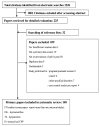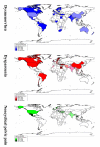WHO systematic review of prevalence of chronic pelvic pain: a neglected reproductive health morbidity
- PMID: 16824213
- PMCID: PMC1550236
- DOI: 10.1186/1471-2458-6-177
WHO systematic review of prevalence of chronic pelvic pain: a neglected reproductive health morbidity
Abstract
Background: Health care planning for chronic pelvic pain (CPP), an important cause of morbidity amongst women is hampered due to lack of clear collated summaries of its basic epidemiological data. We systematically reviewed worldwide literature on the prevalence of different types of CPP to assess the geographical distribution of data, and to explore sources of variation in its estimates.
Methods: We identified data available from Medline (1966 to 2004), Embase (1980 to 2004), PsycINFO (1887 to 2003), LILACS (1982 to 2004), Science Citation index, CINAHL (January 1980 to 2004) and hand searching of reference lists. Two reviewers extracted data independently, using a piloted form, on participants' characteristics, study quality and rates of CPP. We considered a study to be of high quality (valid) if had at least three of the following features: prospective design, validated measurement tool, adequate sampling method, sample size estimation and response rate >80%. We performed both univariate and multivariate meta-regression analysis to explore heterogeneity of results across studies.
Results: There were 178 studies (459975 participants) in 148 articles. Of these, 106 studies were (124259 participants) on dysmenorrhoea, 54 (35973 participants) on dyspareunia and 18 (301756 participants) on noncyclical pain. There were only 19/95 (20%) less developed and 1/45 (2.2%) least developed countries with relevant data in contrast to 22/43 (51.2%) developed countries. Meta-regression analysis showed that rates of pain varied according to study quality features. There were 40 (22.5%) high quality studies with representative samples. Amongst them, the rate of dysmenorrhoea was 16.8 to 81%, that of dyspareunia was 8 to 21.8%, and that for noncyclical pain was 2.1 to 24%.
Conclusion: There were few valid population based estimates of disease burden due to CPP from less developed countries. The variation in rates of CPP worldwide was due to variable study quality. Where valid data were available, a high disease burden of all types of pelvic pain was found.
Figures





Similar articles
-
Nifedipine for primary dysmenorrhoea.Cochrane Database Syst Rev. 2021 Dec 18;12(12):CD012912. doi: 10.1002/14651858.CD012912.pub2. Cochrane Database Syst Rev. 2021. PMID: 34921554 Free PMC article.
-
Surgical interventions for the management of chronic pelvic pain in women.Cochrane Database Syst Rev. 2021 Dec 20;12(12):CD008212. doi: 10.1002/14651858.CD008212.pub2. Cochrane Database Syst Rev. 2021. PMID: 34923620 Free PMC article.
-
Oral contraceptives for pain associated with endometriosis.Cochrane Database Syst Rev. 2018 May 22;5(5):CD001019. doi: 10.1002/14651858.CD001019.pub3. Cochrane Database Syst Rev. 2018. PMID: 29786828 Free PMC article.
-
Physical activity for treatment of irritable bowel syndrome.Cochrane Database Syst Rev. 2022 Jun 29;6(6):CD011497. doi: 10.1002/14651858.CD011497.pub2. Cochrane Database Syst Rev. 2022. PMID: 35766861 Free PMC article.
-
Herbal and dietary therapies for primary and secondary dysmenorrhoea.Cochrane Database Syst Rev. 2001;(3):CD002124. doi: 10.1002/14651858.CD002124. Cochrane Database Syst Rev. 2001. Update in: Cochrane Database Syst Rev. 2016 Mar 22;3:CD002124. doi: 10.1002/14651858.CD002124.pub2. PMID: 11687013 Updated.
Cited by
-
Chronic Pelvic Pain: A Comprehensive Review.Cureus. 2022 Oct 26;14(10):e30691. doi: 10.7759/cureus.30691. eCollection 2022 Oct. Cureus. 2022. PMID: 36465795 Free PMC article. Review.
-
Safety and efficacy of therapeutic taping in primary dysmenorrhea: a systematic review and meta-analysis.Sci Rep. 2022 May 3;12(1):7146. doi: 10.1038/s41598-022-11034-w. Sci Rep. 2022. PMID: 35504906 Free PMC article.
-
High rate of dyspareunia and probable vulvodynia in Ehlers-Danlos syndromes and hypermobility spectrum disorders: An online survey.Am J Med Genet C Semin Med Genet. 2021 Dec;187(4):599-608. doi: 10.1002/ajmg.c.31939. Epub 2021 Nov 7. Am J Med Genet C Semin Med Genet. 2021. PMID: 34747110 Free PMC article.
-
The effect of pelvic pain and urinary incontinence on women's self-rated health in northern Mexico.Int Urogynecol J. 2018 Feb;29(2):243-250. doi: 10.1007/s00192-017-3537-7. Epub 2018 Jan 8. Int Urogynecol J. 2018. PMID: 29313090
-
Efficacy of Internet-Based Guided Treatment for Genito-Pelvic Pain/Penetration Disorder: Rationale, Treatment Protocol, and Design of a Randomized Controlled Trial.Front Psychiatry. 2018 Jan 22;8:260. doi: 10.3389/fpsyt.2017.00260. eCollection 2017. Front Psychiatry. 2018. PMID: 29403395 Free PMC article.
References
-
- Howard FM. The role of laparoscopy in chronic pelvic pain: promise and pitfalls. Obstet Gynecol Surv. 1993;48:357–387. - PubMed
-
- Davies L, Ganger K, Drummond M, Saunders D, Beard R. The economic burden of intractable gynaecological pain. J Obstet Gynecol. 1992;12:46–54.
Publication types
MeSH terms
LinkOut - more resources
Full Text Sources
Other Literature Sources
Medical

